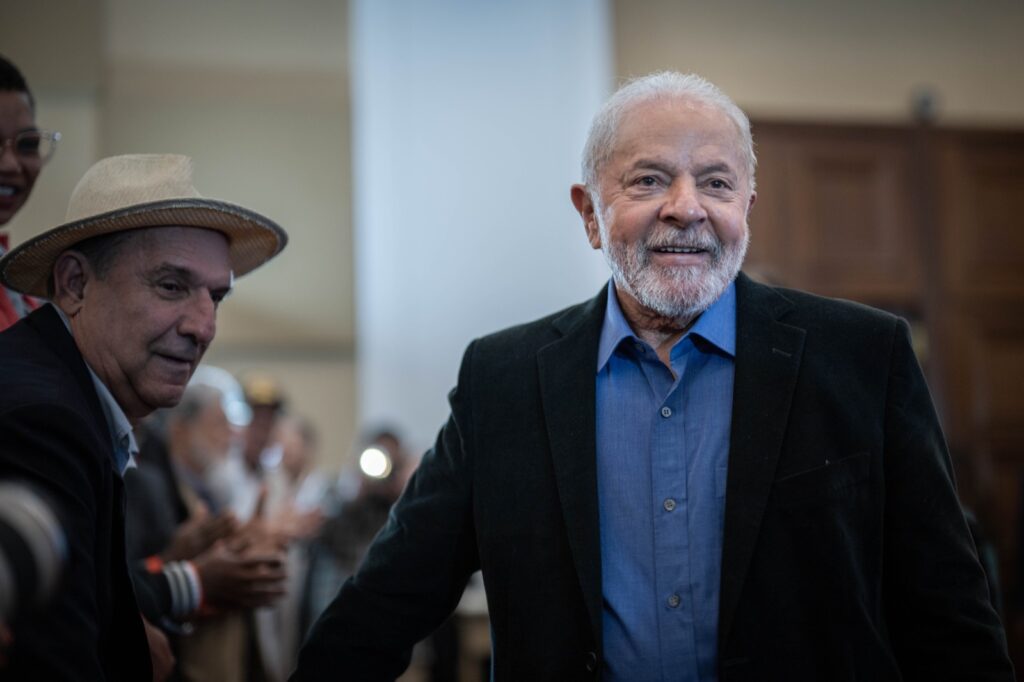
Luiz Inácio Lula da Silva nació en 1945, en la zona semiárida del estado de Pernambuco, en el noreste de Brasil y fue el séptimo hijo de una pareja de labradores. Sin servicios básicos como luz, agua o baño, su familia se mudó al sur en busca de mejor suerte, para huir de la sequía y la pobreza.
En São Paulo, Lula comenzó a trabajar desde niño, al concluir la primaria fue empleado en una metalúrgica y fue admitido en el curso técnico de tornero mecánico. Por esos años, São Paulo se convirtió en la zona más industrializada del país, con algunas de las principales metalúrgicas del mundo.
De tal forma, da Silva fue uno de los muchos migrantes nordestinos que se instalaron en la línea de producción e hicieron de la metalurgia su profesión. Cabe destacar que a los 17 años perdió el dedo meñique de la mano izquierda en un accidente de trabajo y a los 18 vivió el golpe militar de 1964.
Convencido por un hermano, militante del entonces clandestino Partido Comunista Brasileño, comienza a frecuentar reuniones del sindicato, en donde entra en contacto con las necesidades de la clase trabajadora y a estar en contacto con expresiones como devaluación salarial, carestía y fondo de huelga.
Debido a sus cualidades de negociador, lo invitaron a ocupar una plaza de suplente en la dirección del sindicato, electa al inicio de 1969, inaugurando su trayectoria como líder sindical.
Tras casarse a los 23 años, y luego de perder a su mujer y a su hijo al dar a luz, se sumerge en el trabajo y es convocado a asumir un puesto en la dirección del sindicato, cambiando por primera vez el turno en la fábrica por una sala en la sede de la entidad.
En 1975, antes de cumplir 30 años, Lula asume la presidencia del sindicato. Esta segunda mitad de 1970 se caracterizó por la radicalización de los movimientos de reivindicación de la clase trabajadora, atrayendo el entusiasmo y solidaridad de militantes de izquierda que no encontraban espacio para actuar en sus áreas de origen.
Entre 1978 y 1980, Lula comanda diversas huelgas generales, mismas que asumen proporciones impensables, afianzándose como el mayor nombre de la oposición en el escenario político del país; sin embargo, el 19 de abril de 1980 estuvo preso y pasó 31 días en la cárcel.
Trayectoria política
Cuando surge el Partido de los Trabajadores es prontamente apoyado e influenciado por intelectuales, religiosos, artistas, estudiantes y militantes egresados de la lucha armada, y Lula fue su primer presidente. Así, durante dos décadas fue portavoz de los trabajadores y principal líder de la oposición, dejando marcas en el modelo de democracia instalado en el país.
En 1990 estuvo al frente del Instituto Ciudadanía, en el que se formularon políticas públicas implementadas en la década siguiente, como el Hambre Cero; también presidió el PT en la campaña por el Impeachment de Collor y algunas de las más importantes Comisiones Parlamentarias de Investigación del período, como la que denunció la violación del panel del Senado, en 1991, y el escándalo de los enanos del Presupuesto, en 1993.

Durante los ocho años de administración de Fernando Henrique Cardoso, hizo oposición a la política económica recesiva, a la manipulación del tipo de cambio de modo para mantener la moneda artificialmente fuerte y a la compra de votos a cambio de la aprobación del proyecto de ley que aseguró el derecho a la reelección, en 1997, entre otros.
Después de tres campañas electorales frustradas, Lula fue finalmente electo presidente de la República el 27 de noviembre de 2002, y fue el primer obrero que se instaló como inquilino en el Palacio de la Alvorada.
Reelecto para un segundo mandato, Lula eligió a su sucesora, Dilma Rousseff, y llegó al final del gobierno con récord de popularidad, puesto que su administración fue aprobada por el 87% de la población en diciembre de 2010, según el Ibope.
Sus dos gobiernos llevaron la marca de la implementación de programas de distribución de ingresos, como el Bolsa Familia, y del acceso de los más pobres a líneas de crédito, así como salarios más altos, generación de empleos, así como diversas iniciativas en materia de educación.
Con información de Lula Institute.
Esta nota se realizó con el apoyo de la organización Global Exchange en colaboración con Península 360 Press.
Te puede interesar: Es oficial, Lula y Bolsonaro se van a una segunda vuelta electoral en Brasil

